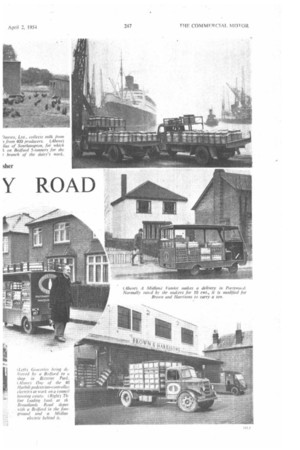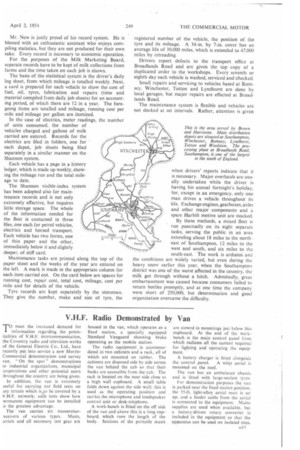GALLONS OF MILK ROAD
Page 52

Page 53

Page 54

Page 55

If you've noticed an error in this article please click here to report it so we can fix it.
Eight Separate Tasks Undertaken by 1 1 8 Electric, Petrol and Oil-engined Vehicles and Some 80 Horsed .Carts Operated by the Biggest Dairy in Southampton
By A. E.
sher A' I.-least 85 per cunt. of the population of.Southarnptbn, I am told, buy their milk from Brown and Harrisons Dairies, Ltd.. It comes .to them in a fleet of smart green and red vehicles in which every form of motive power is represented—electric, petrol, oil and horse. Last year the fleet covered nearly im. miles--467,545 miles on retail distribution—and carried 7m. gallons of milk.
To the great sorrow of the joint managing director and some of the older hands, the horses are giving place to electricS, but up to 80 will stilt be at work daily. Four of the depots have already been converted completely to electric traction and others will follow.
— Electries are replacing not only horses, but petrol. vehicles on the longer runs. The low cost of operation of the electric vehicle and its cleanliness are decisive influences. Taking maintenance and depreciation expenses alone, the comparison is striking.
. I have examined figures that show that a 10-cwt. petrol vehicle is more costly to run than a petrol 1-tonner, but that a 1-ton electric is more economical than either. These figures illustrate the contention of Mr. J. New, A.M.I.M.I., transport manager, that a larger vehicle is cheaper in the long run because it is more robust, as well as emphasizing the longer life and good wearing qualities of the electric.
A comparison of maintenance and depreciation costs of electries on short-range work reveals that a pedestrian-controlled 1-ton outfit costs less per gallon of milk delivered than a driven 1-ton four-wheeler.
... The company are, however, not pledged irrevocably to electries and are experimenting with a Trojan I -ton van, with Perkins P3 oil engine, for retail milk delivery. The vehicle, which was supplied by Munn and Underwood. Ltd., Southampton, has not been used long enough for firm conclusions to be drawn, but it soon showed that its fuel consumption was about half that of an equivalent petrol vehicle.
The fleet of mechanical vehicles totals 118. There are 28 Bedford (23 5-ton lorries, four 5-ton vans and a 24-tonner), 16 Thames 10-cwt. vans, 11 Morris o 1 2 Commercial (two 30-cwt. lorries and nine 1-ton vans), a Trojan, 40 Harbilt pedestrian-controlled electric i-tonners, 19 Midland electrics (three 1-tonners and 16 Vandots) and two Wales and Edwards 1-tonners. Eight Midland 1-tonners are on order and will be used on rounds of up to 28 miles.
A Karrier 24-tonner is being converted into a breakdown vehicle with a winch at the rear. The frame is being lengthened so that light vehicles can be carried. They will he winched up a ramp.
A variety of bodywork is used. The Thames and
Morris-Commercial vehicles on retail deliveries have standard bodies and the electrics on rounds have canopies and open sides. The Bedfords used to collect milk from farms have platforms with short detachable upper decks behind the cabs.
The Bedford lorries delivering bottled milk to depots have stake sides with tensioned chains. Groceries are delivered in' a Bedford boxvan with roller shutters at the rear and on the near side. The bodies of the Bedford and Midland vehicles are built to Brown and Harrisons' own specification by Messrs. Longman Bros., Redbridge, Southampton.
The fleet is distributed over II depots and a garage. The largest number (43) is at Broadlands Road, Southampton, where the company have one of the largest and most modern milk-processing plants in the south of England. On one side of the building is a long bank to which empty bottles are delivered and are removed by conveyor to the washing plant. Filled churns are also received there and again moved by conveyor to the weighing machine, where they are emptied. Filled • bottles of milk are loaded on a bank on the other side of the processing depot. '
Six Main Distribution Depots
Main distributing depots are well placed in Southampton, Winchester, Ramsey, Lyndhurst, Totton and Woolston. When fully mechanized Winchester will have 24 petrol and electric vehicles.
The transport department has eight main tasks. These are:—
(1) The retail distribution of dairy products to 58,000 customers on 167 rounds.
(2) Supplying the depots with over 139,000 bottles of milk per day.
(3) Delivering groceries to 15 shops (nine in Southampton, one in Totton, one in Lyndhurst, one in Romsey and three in Winchester). The Bedford 5-ton boxvan engaged on this work last year covered 11,906 miles.
(4) Delivering 1,400 gallons of milk daily to 198 school buildings within 10 miles of Southampton and collecting over 34,000 empty bottles the same day, and supplying milk to 17 hospitals and convalescent homes. In a year, this service, coupled with depot work, involves 231,000 miles' haulage.
(5) Taking milk to ships at the docks to the order of 20 shipping lines or their agents. This is the only work that fluctuates seasonally, for the docks are much busier in summer than at other times of the year. It can be planned ahead, but it must be conducted to a rigid timetable. Large quantities are called for and at times two 5-tonners are required for a delivery to a ship. Churns and bottles have to be collected when vessels D14 return to port. Although the docks are only about four miles from the depot, deliveries to ships last year accounted for 8,000 miles of running.
(6) Collectiug milk from 400 producers. Nine farm runs are undertaken by Brown and Harrisons and 15 by contractors. Up to 20,000 gallons of milk are collected daily from the New Forest and bordering districts. The Bedfords engaged on this service last year covered 114,400 miles.
(7) Collecting eggs within a 20-mile radius of Southampton. At the peak, there are 800 producers supplying Brown and Harrisons and each week up to 692 cases, containing 249,120 eggs, are collected, graded and distributed. Two Bedford 5-tonners are employed on the work, travelling between 'them 31,900 miles in 1953.
(8) Delivering wholesale milk to cafés, restaurants, hotels and canteens, and to 10 retailers in the New Forest district. This work alone involves the daily transport of 500 gallons of milk in bottles and last year accounted for 9,100 miles by a Bedford 5-tonner.
Retail delivery rounds are arranged in compact blocks and although it may be necessary for a roundsman to pass through aeother's area to reach his own, there is no duplication of working on any round. The average length of round for a pedestrian-controlled vehicle is four miles, for the Midland Vandots nine miles and for the Midland 1-tonners 10 miles, although this figure is to be extended when the new vehicles take over from some of the motors. The petrol and oil-engined vans are engaged on rounds of up to 35 miles. On an average, a round occupies seven hours, although delivery may take a little longer on Saturdays.
Mileages on Retail Delivery
The 61 electrics, which are all engaged on retail delivery, last year covered 103,660 miles. The nine Morris-Commercial 1-tonners employed on similar work travelled 119,900 miles and the Ford 10-cwt. vans, which do also transport to depots and' maintenance work, put up 148,800 miles. By comparison, the 89 horse-drawn vehicles covered 191,240 miles. Petrol vehicles on retail deliveries travel 473 miles a day, the electrics 284 miles and the horses 524 miles, giving annual totals of 172,645 miles, 103.660 miles and 199,240 miles respectively. The biggest mileage is covered from Winchester, where the depot serves outlying districts. Mr. New is justly proud of his record system. He is blessed with an enthusiastic assistant who enjoys compiling statistics, but they are not produced for their own sake. Every record is necessary to economic operation.
For the purposes of the Milk Marketing Board, separate records have to be kept of milk collections from farms and the time taken on each job is shown.
The basis of the statistical system is the driver's daily log sheet, from which mileage is totalled weekly. Next, a card is prepared for each vehicle to show the cost of fuel, oil, tyres, lubrication and repairs (time and material compiled horn daily job sheets) for an accounting period, of which there are 12 in a year. The foregoing items are totalled and mileage, running cost per mile and mileage per gallon are itemized.
In the case of electrics, meter readings, the of units consumed, the number of vehicles charged and gallons of milk carried are entered, Records for the electrics are filed in folders, one for each depot, job sheets being filed separately in a similar manner on the Shannon system.
Each vehicle has a page in a history ledger, which is made up weekly, showing the mileage run and the total mileage to date.
The Shannon visible-index system has been adopted also for maintenance records and is not only extremely effective, but requires little storage space. The whole of the information needed for the fleet is contained in three files, one each for petrol vehicles, electrics and horsed transport. Each vehicle has two forms, one of thin paper and the other, immediately below it and slightly deeper, of stiff card.
Maintenance tasks are printed along the top of the paper sheet and the weeks of the year are entered on the left. A mark is made in the appropriate column for each item carried out. On the card below are spaces for running cost, repair cost, total cost, mileage, cost per mile and for details of the vehicle.
Tyre records are kept separately by the storeman. They give the number, make and size of tyre, the number registered number of the vehicle, the position of the tyre and its mileage. A 34-in. by 7-in, cover has an average life of 30,000 miles, which is extended to 47,000 miles by retreading.
Drivers report defects to the transport office at Broadlands Road and are given the top copy of a duplicated order to the workshops. Every seventh or eighth day each vehicle is washed, serviced and checked.
Small repairs and servicing to vehicles based at Romsey, Winchester, Totton and Lyndhurst are done by local garages, but major repairs are effected at Broadlands Road.
The maintenance system is flexible and vehicles are not docked at set intervals. Rather, attention is given when drivers' reports indicate that it is necessary. Major overhauls are usually undertaken while the driver is having his annual fortnight's holiday, for, except in an emergency, only one man drives a vehicle throughout its life. Exchange engines, gearboxes, axles and other major components and a spare Harbilt motive unit are stocked.
By these methods, a mixed fleet is run punctually on its eight separate tasks; serving the public in an area extending about 18 miles to the northeast of Southampton, 12 miles to the west and south, and six miles to the south-east. The work is arduous and the conditions are widely varied, but even during the heavy snow earlier this year, when the Southampton district was one of the worst affected in the country, the milk got through without a hitch. Admittedly, great embarrassment was caused because consumers failed to return bottles promptly, and at one time the company were short of 250,000, but determination and good organization overcame the difficulty.








































































































